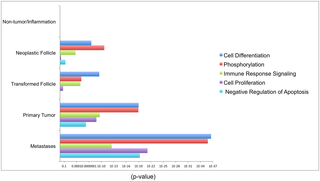PLoS Pathogens ( IF 6.7 ) Pub Date : 2017-11-03 , DOI: 10.1371/journal.ppat.1006708 Sanandan Malhotra , Shelby Winans , Gary Lam , James Justice , Robin Morgan , Karen Beemon

|
Avian leukosis virus (ALV) is a simple retrovirus that causes a wide range of tumors in chickens, the most common of which are B-cell lymphomas. The viral genome integrates into the host genome and uses its strong promoter and enhancer sequences to alter the expression of nearby genes, frequently inducing tumors. In this study, we compare the preferences for ALV integration sites in cultured cells and in tumors, by analysis of over 87,000 unique integration sites. In tissue culture we observed integration was relatively random with slight preferences for genes, transcription start sites and CpG islands. We also observed a preference for integrations in or near expressed and spliced genes. The integration pattern in cultured cells changed over the course of selection for oncogenic characteristics in tumors. In comparison to tissue culture, ALV integrations are more highly selected for proximity to transcription start sites in tumors. There is also a significant selection of ALV integrations away from CpG islands in the highly clonally expanded cells in tumors. Additionally, we utilized a high throughput method to quantify the magnitude of clonality in different stages of tumorigenesis. An ALV-induced tumor carries between 700 and 3000 unique integrations, with an average of 2.3 to 4 copies of proviral DNA per infected cell. We observed increasing tumor clonality during progression of B-cell lymphomas and identified gene players (especially TERT and MYB) and biological processes involved in tumor progression.
中文翻译:

禽白血病病毒整合位点的选择决定了B细胞淋巴瘤的克隆进程
禽白血病病毒(ALV)是一种简单的逆转录病毒,可在鸡中引起多种肿瘤,其中最常见的是B细胞淋巴瘤。病毒基因组整合到宿主基因组中,并利用其强大的启动子和增强子序列来改变附近基因的表达,从而经常诱发肿瘤。在这项研究中,我们通过分析超过87,000个独特的整合位点,比较了培养细胞和肿瘤中ALV整合位点的偏好。在组织培养中,我们观察到整合相对随机,对基因,转录起始位点和CpG岛略有偏爱。我们还观察到表达或剪接基因中或附近整合的偏好。在选择肿瘤过程中的致癌特性过程中,培养细胞中的整合模式发生了变化。与组织培养相比,ALV整合的选择更高,以接近肿瘤中的转录起始位点。在肿瘤中高度克隆扩增的细胞中,还有远离CpG岛的ALV整合。此外,我们利用高通量方法来量化肿瘤发生不同阶段的克隆性大小。ALV诱导的肿瘤进行700到3000次独特整合,每个感染的细胞平均有2.3到4份原病毒DNA拷贝。我们观察到在B细胞淋巴瘤进展过程中肿瘤克隆性增加,并且发现了基因参与者(尤其是 我们利用高通量方法来量化肿瘤发生不同阶段中克隆性的大小。ALV诱导的肿瘤进行700到3000次独特整合,每个感染的细胞平均有2.3到4份原病毒DNA拷贝。我们观察到B细胞淋巴瘤进展过程中肿瘤克隆性增加,并且发现了基因参与者(尤其是 我们利用高通量方法来量化肿瘤发生不同阶段中克隆性的大小。ALV诱导的肿瘤进行700到3000次独特整合,每个感染的细胞平均有2.3到4份原病毒DNA拷贝。我们观察到在B细胞淋巴瘤进展过程中肿瘤克隆性增加,并且发现了基因参与者(尤其是TERT和MYB)以及与肿瘤进展有关的生物学过程。



























 京公网安备 11010802027423号
京公网安备 11010802027423号